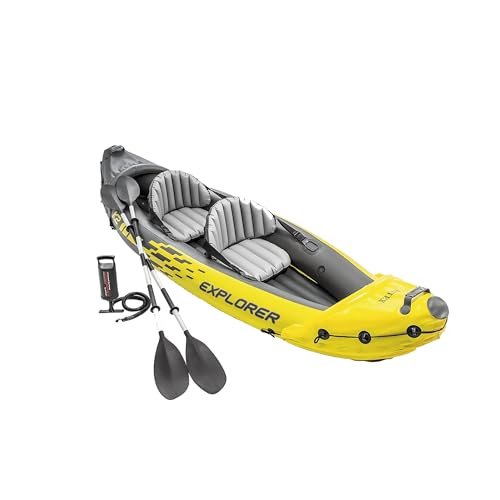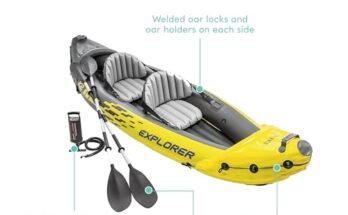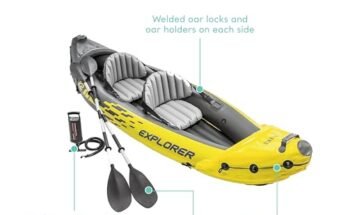Are you thinking about kayaking alone but wondering if it’s truly safe? You’re not alone in asking this question.
Kayaking solo can feel freeing and peaceful, but it also brings unique risks you need to understand. Before you grab your paddle and head out, it’s important to know what to expect and how to stay safe on the water.
Keep reading, because this guide will help you make smart choices and enjoy your solo kayak trips with confidence.

Risks Of Solo Kayaking
Kayaking alone can be peaceful and fun. It lets you enjoy nature and quiet water.
Still, solo kayaking has risks. You must know what dangers you may face.
Common Hazards On The Water
Water can be unpredictable. Strong currents can pull you off course. Rocks and logs may block your way.
You may tip over if waves are high or wind is strong. Falling in cold water can cause shock or hypothermia.
- Strong currents and tides
- Hidden rocks and debris
- Sudden waves and wind gusts
- Cold water dangers
Weather And Environmental Challenges
Weather can change fast on the water. Rain, fog, or storms reduce visibility and make paddling hard.
Heat and sun can cause dehydration or sunburn. Always check weather before you go and be ready.
- Sudden storms and rain
- Fog and low visibility
- Strong sun and heat
- Cold temperatures
Wildlife Encounters
Wild animals live near water. Most avoid people but some may come close or act defensively.
Large birds or animals can scare you or tip your kayak. Know local wildlife and keep distance.
- Birds nesting near shore
- Fish jumping near kayak
- Curious mammals on shore
- Potentially aggressive animals
Preparing For Solo Trips
Kayaking alone can be a peaceful and rewarding experience. It needs careful preparation to stay safe on the water.
Planning ahead helps you enjoy your trip without unexpected problems. Focus on equipment, fitness, and route planning.
Choosing The Right Equipment
Pick gear that fits your skill and the water conditions. Safety gear is very important for solo kayaking.
Wear a life jacket at all times. Bring a whistle, paddle leash, and dry bags for your items.
- Use a kayak suited for your trip type and water
- Always wear a properly fitted life jacket
- Carry a paddle leash to avoid losing your paddle
- Pack a whistle or signaling device for emergencies
- Bring waterproof bags for your phone, keys, and snacks
Physical And Mental Readiness
Make sure you are fit enough for the trip. Kayaking alone needs good strength and endurance.
Stay calm and focused. Being mentally prepared helps you handle surprises on the water.
- Practice paddling skills before the trip
- Build endurance with regular exercise
- Learn basic rescue and self-help techniques
- Stay aware of your limits and rest if needed
- Stay calm in tough situations to think clearly
Planning Your Route
Plan your route carefully. Know the distance, water conditions, and exit points.
Tell someone your plan and expected return time. Check the weather before you start paddling.
- Choose a route within your skill level
- Identify safe spots to stop or rest
- Check local weather and water forecasts
- Inform a friend or family about your trip details
- Carry a map, compass, or GPS device
Safety Gear Essentials
Kayaking alone can be peaceful but also risky without the right gear. Safety equipment helps protect you in emergencies.
Wearing proper safety gear lowers the chance of accidents and keeps you prepared on the water.
Personal Flotation Devices
A personal flotation device (PFD) keeps you afloat if you fall into the water. Always wear one that fits well and is approved by safety standards.
- Choose a PFD designed for kayaking
- Check straps and buckles for secure fit
- Wear it at all times on the water
Communication Tools
Communication tools help you call for help if needed. They are essential when kayaking alone in remote areas.
| Tool | Purpose | Tips |
| Whistle | Signal nearby help | Attach to PFD for easy access |
| Waterproof Phone Case | Keep phone dry | Use only if you have signal |
| VHF Radio | Talk to rescue teams | Learn basic operation before trips |
Emergency Supplies
Emergency supplies help you handle accidents or bad weather. Pack items that fit in your kayak and are easy to reach.
- First aid kit with bandages and antiseptic
- Waterproof flashlight or headlamp
- Extra paddle in case of breakage
- Emergency blanket for warmth
- Knife or multi-tool for quick fixes

Techniques For Staying Safe
Kayaking alone can be peaceful but needs careful planning. Knowing safety techniques helps prevent accidents.
Use simple steps to stay safe on the water. Prepare well before you launch your kayak by yourself.
Launching And Landing Solo
Launching and landing alone requires balance and care. Pick calm water spots with easy access to shore.
Use stable surfaces and keep your kayak steady. Move slowly to avoid tipping over when getting in or out.
- Check water depth and current before launching
- Place paddle across the kayak for balance
- Enter the kayak from the shore or dock carefully
- When landing, slow down and aim for a flat spot
- Exit the kayak slowly, holding onto a stable object if possible
Self-rescue Methods
Knowing how to rescue yourself is very important. Practice these skills in calm water before going out alone.
If you fall out, stay calm and keep your kayak nearby. Use your paddle to help get back in safely.
- Hold the kayak and paddle firmly
- Position yourself at the side of the kayak
- Kick your legs and pull yourself on top
- Use the paddle for support if needed
- If you can’t get back, float on your back and wait for help
Navigation And Orientation
Good navigation helps you avoid getting lost. Learn to read maps and use a compass or GPS device.
Watch landmarks like trees, buildings, or hills. Keep track of your position and direction as you paddle.
- Plan your route before starting
- Check the weather and water conditions
- Mark key points on your map or GPS
- Look back often to see where you came from
- Stay aware of time and daylight
Communicating Your Plans
Kayaking alone can be peaceful but it also has risks. Telling someone your plans helps keep you safe.
Good communication means others know where you are and when to expect you back.
Informing Friends Or Family
Tell a trusted friend or family member about your kayaking trip. Share your start time, route, and expected return time.
Ask them to check on you if you do not return on time. This way, someone will notice if you need help.
Using Check-in Systems
Use a check-in system to update others about your status. This can be a phone call, text, or app message.
Set specific times to check in during your trip. This lets others know you are safe and on track.
- Check in before you leave
- Send updates at planned stops
- Notify when you finish
Emergency Contact Protocols
Have a clear plan for emergencies. Share emergency contacts with someone you trust.
Keep emergency numbers saved on your phone and written on waterproof paper. Know how to call for help quickly.
- Local emergency services number
- Contact info for your trusted friend or family
- Nearby rescue or park services
Legal And Local Regulations
Kayaking alone can be a peaceful adventure. Knowing the rules keeps it safe and fun. Different places have different laws and guidelines.
Understanding these laws helps you avoid trouble. Always check the local rules before heading out on the water.
Permits And Access Rules
Some areas need a permit to kayak. Permits help manage how many people use the water. They protect the environment and ensure safety.
Check with local authorities for permit requirements. Make sure you have all the needed papers before you start kayaking.
- Contact local park services for permit details
- Some permits can be bought online
- Keep your permit with you while kayaking
Restricted Areas To Avoid
Certain places may not allow kayaks. These areas might be protected or have dangerous conditions. Respect the signs and rules.
Avoid these places to stay safe and protect nature. Check maps and guides for marked restricted zones.
- Stay clear of wildlife protection zones
- Avoid areas with strong currents
- Respect private property boundaries
Environmental Considerations
Kayaking alone means you should be extra careful with the environment. Be aware of how your actions affect nature.
Follow guidelines to minimize harm. Help keep the water and surroundings clean and safe.
- Do not litter in the water or on the shore
- Use eco-friendly gear and products
- Respect wildlife and their habitats

Frequently Asked Questions
Is Kayaking Alone Safe For Beginners?
Kayaking alone can be risky for beginners due to lack of experience. It’s safer to start with a group or instructor. Always wear a life jacket and inform someone about your plans before solo kayaking.
What Safety Gear Is Essential For Solo Kayaking?
Essential safety gear includes a life jacket, whistle, paddle leash, and waterproof communication device. Wearing proper clothing and carrying a first-aid kit also enhances safety during solo kayaking trips.
How Can I Prepare For Kayaking Alone?
Prepare by learning basic kayaking skills and practicing self-rescue techniques. Check weather conditions and water currents. Plan your route and share it with someone trustworthy before heading out alone.
When Is The Best Time To Kayak Alone Safely?
The best time to kayak alone is during calm weather and daylight hours. Avoid strong winds, heavy currents, or poor visibility. Early mornings or late afternoons often offer safer, quieter conditions for solo kayaking.
Conclusion
Kayaking alone can be safe with the right preparation and care. Always check weather conditions before you go. Wear a life jacket and carry safety gear. Tell someone your plans and expected return time. Stay close to shore and avoid risky waters.
Trust your skills but stay cautious at all times. Solo kayaking offers peace and freedom, but safety comes first. Enjoy the water while respecting its power. Stay alert, prepared, and confident on your journey.



